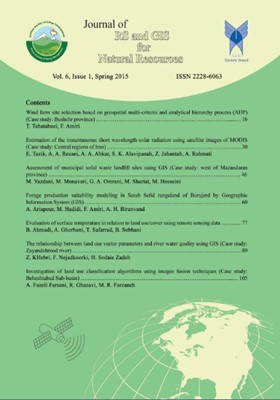Estimation of the instantaneous short wavelength solar radiation using satellite images of MODIS (Case study: Central regions of Iran)
Subject Areas : Geospatial systems developmentEsmaeil Tazik 1 , Abdol Ali Rezaei 2 , Ali Abkar 3 , Seyed Kazem Alavipanah 4 , Zahra Jahantab 5 , Alireza Rahmati 6
1 - MSc. of Remote sensing and Geographic Information System, Department of Cartography, University of Tehran, Iran
2 - PhD. Student of Remote sensing and Geographic Information System, Department of Cartography, University of Tehran, Iran
3 - Assoc. Prof. Department of Remote Sensing, Khaje Nasir Toosi University of Technology, Iran
4 - Prof. Department of Cartography, University of Tehran, Iran
5 - MSc. of Remote sensing and Geographic Information System, Department of Environment, Tehran North Branch, Islamic Azad University, Tehran, Iran
6 - MSc. Student of Remote sensing and Geographic Information System, Department of Cartography, University of Tehran, Iran
Keywords:
Abstract :
Using renewable energy, particularly solar radiation is considered today as one of the most important energy sources. Therefore the study of solar energy is very important. Although the sun is a great source of energy, but the energy output at ground level does not act alike, so that the amount of solar radiation in different parts of the world is changing and it is high in low latitudes. Thus, identifying appropriate locations for implementation of solar energy is necessary. The best and most accurate way to measure this parameter is using devices that measure radiation in stations, but because of natural, economic conditions and other conditions we cannot use them On the other hand, these devices have a limited radius of point measurements. So, in recent years using satellite images these problems have been resolved partially. Therefore, in this study using satellite images of MODIS sensor and narrow band to broadband albedo conversion method, the instantaneous short-wave solar radiation in the central Iranian province of Qom, Isfahan, Tehran and Semnan was estimated. To analyze the results of the coefficient of determination (R2) root mean square error (RMSe) and the mean average error (MAE) was used. Consequently the rate of RMSE was about 42 watts per square meter and MAE rate was about 40.75 watts per square meter indicating the high accuracy of the method used to estimate radiation.


